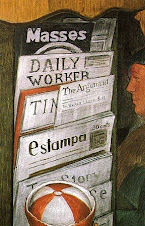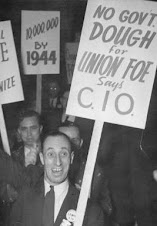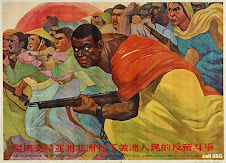Remembering Lin Biao
By Caleb T. Maupin
Published Dec 5, 2007 9:24 PM
It is 100 years since Lin Biao, an outstanding military leader in China’s anti-feudal, anti-imperialist revolutionary war and later a political leader in the Cultural Revolution, was born on Dec. 5, 1907.
After his death in 1971, Lin was almost erased from public recognition in China. But in July, the Shanghai Daily News reported that Lin had finally been returned to hero status and his portrait placed in the Beijing Military Museum.
Who was Lin Biao? Why should he be remembered?
Lin came from the Chinese countryside, which was impoverished and oppressed by feudal landlords. At an early age he developed a desire to see things change. At 18 he left home, joined the Socialist Youth League and became a student at the Whampoa Military Academy, a hotbed of nationalist and Marxist thought.
Lin studied alongside Zhou Enlai and many others who would become leaders of China’s socialist revolution. A civil war broke out between the feudalists and the nationalist forces in which Lin commanded nationalists in battles against the regime of emperors and landlords.
In 1928, Chiang Kai-shek, head of the nationalist Kuomintang party, turned on his Communist allies, slaughtering thousands. Lin, Mao Zedong, Zhou and other Communists eventually regrouped and established a new army that fought the ruling classes. Its aim was to put the factories, the land and political power in the hands of the workers and peasants, the overwhelming majority of the Chinese people.
Lin and Mao both mastered the art of guerilla warfare. Their strategy of “people’s war” depended on the support of ordinary people to gradually build up a new kind of army, highly political and democratic.
Anti-Japanese war of resistance
In the 1930s and 1940s, Lin and Mao led a guerrilla war against Japan’s invading imperialist army. In the areas controlled by their People’s Liberation Army, land was distributed to the poor peasants, who combined with Communist Party cadres to run their villages in the interest of the people. Ordinary people for the first time had a say in decision making. The landlords and nobles were tried for their crimes against the people.
Lin and Mao were seen as Robin Hoods. Tens of thousands of Chinese people began to join their ranks, seeking to build a socialist future in China.
In 1949, the revolution was victorious and Chiang Kai-shek, who had been supported by the U.S., fled to Taiwan. “The Chinese people have stood up!” proclaimed Mao to a giant rally. Lin, whose troops had just liberated the capital, was at his side.
In 1959, Lin became China’s defense minister. He abolished privileges for officers and insignia of rank.
In 1966, students at Tsinghua University hung “big character posters” attacking elitism and bureaucratic tendencies and formed the Red Guards. Mao and Lin came out strongly in support of the students’ “right to rebel.” It was the beginning of a massive revolution within the revolution. Chinese youth became a fighting force against those who defended capitalist restoration and elitist policies.
In the state-owned factories, workers began to criticize their bosses. In the schools, teachers once above criticism became targets of massive student dissent. Empowering the common people and the collective became the rallying cry of what would be known as the Great Proletarian Cultural Revolution.
Lin, acting as Mao’s official representative during this period, wrote a book, “Long Live the Victory of People’s War,” that said a world revolution was going on against the U.S. imperialists. It argued that the underdeveloped world and forces of socialism and communism could surround and overwhelm the imperialists.
When the workers of Shanghai, China’s most industrial city, revolted, Mao and Lin began to develop different views. The workers of Shanghai set up a new government in their city modeled after the Paris Commune. Its leaders were subject to immediate recall by the workers. There was free speech and total access to the media by common people.
Lin was blown away by what he witnessed in Shanghai. He called for all China to become a Commune state. No more bureaucracy, he proclaimed. Direct democratic control by workers’ councils. He was joined by , Jiang Qing, Mao's partner, and others later labeled as the “gang of four.”
But Mao disagreed. He argued that doing so would give rise to “bonapartism.” Mao felt the Commune was too weak to suppress the opposition.
Lin also began to advocate a better relationship with the Soviet Union. Lin viewed all the socialist countries as on the same side in the people’s war raging across the world. But Mao had begun to proclaim that the Soviet Union was a “social imperialist empire” and the “main danger to the people of the world.”
Lin and Mao’s disagreements grew acute. Lin died on Sept. 13th, 1971, in mysterious circumstances.
The official story is that Lin tried to assassinate Mao but failed and died in a plane crash while trying to escape to the Soviet Union.
The founder of Workers World Party, Sam Marcy, argued in his pamphlet “China 1977: End of the Revolutionary Mao Era” that Lin had been killed and that his death represented the beginning of the rightward turn in China.
The view that the Soviet Union was the “main danger” became the official line of the Chinese Communist Party. The next year U.S. President Richard Nixon was invited to Beijing, even as the Pentagon was continuing its war against the peoples of Southeast Asia.
Following Mao’s death, Deng Xiaoping came to power. The leaders of the Cultural Revolution were put on trial for “counter-revolutionary activities.” Soon, China began to adopt policies of “market socialism.” Foreign corporations were free to set up factories on Chinese soil. Many of the socialist policies of the Chinese Revolution, including the job, health and food security guaranteed by state-run communes and factories, were abandoned. However, the Communist Party continued to play the leading role and the state that had emerged from the revolution was not destroyed, as happened later in the USSR.
What followed was an enormous industrialization of China and, along with greater inequality, a huge increase in the size of the working class.
The Chinese Ministry of Labor reports dealing with more than 130,000 cases of “industrial unrest” this year. China is currently undergoing a massive strike wave as workers demand better conditions. There is also a revival of support for the socialist policies and workers’ democracy of the revolutionary period.
It is in this environment that the portrait of Lin Biao was finally placed in the Beijing Military Museum.
The writer is a FIST organizer.
Articles copyright 1995-2007 Workers World. Verbatim copying and distribution of this entire article is permitted in any medium without royalty provided this notice is preserved.
Subscribe to:
Post Comments (Atom)










































5 comments:
You might be interested in another article on Lin Piao's contributions: http://monkeysmashesheaven.wordpress.com/2007/12/05/the-lin-biao-centennial-hooray/
You are wrong to say that Lin Piao advocated an alliance with the USSR. He clearly did not, as is explained in Long Live the Victory of Peoples War. He saw the USSR as working with the USA to divide up the world amongst themselves. And, he never recanted this view. The view you attribute to Lin was actually advocated by those he replaced at the top of the PLA in the 60s. Lin replaced them, in part, because they were for Soviet-Bino unity. In addition, Lin involved with the border wars with the Soviet Union around 69 or 70.
Здравствуйте! Как вы относитесь к молодым композиторам?
Многие возмущаются, что руские слишком часто ругаются матом. Нет, это американцы ругаются, а мы им РАЗГОВАРИВАЕМ Хорошо зафиксированный пациент в анастезии не нуждается Все люди делятся на две категории:
Really great article with very interesting information. You might want to follow up to this topic!?! 2012
Post a Comment